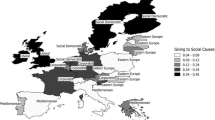Abstract
This paper tests a model where governmentand private charity are perfect substitutesin consumption, but the cost of providingcharitable assistance differs betweenprivate and government suppliers. Theanalysis demonstrates that higher costs oftransferring through the government canaccount for the observed phenomenon of lessthan complete crowding out and theempirical results are broadly consistentwith that approach. Overall the evidenceis consistent with the hypothesis thatindividuals both care about the leakagesinvolved in transferring funds to the poorthrough government and respond in theirprivate giving to changes in thedifferential public cost.
Similar content being viewed by others
References
Alchian, A.A. and Kessel, R.A. (1962). Competition, monoploy, and the pursuit of pecuniary gain. Aspects of labor economics. Princeton: Princeton University Press.
Andreoni, J. (1989). Giving with impure altruism: Applications to charity and Ricardian equivalence. Journal of Political Economy 97: 1447–1458.
Atkinson, A.B. and Stern, N.H. (1974). Pigou, taxation, and public goods. Review of Economic Studies 41: 119–218.
Auten, G.E., Clotfelter, C.T. and Schmalbeck, R.L. (forthcoming 2003). Taxes and philanthropy among the wealthy. In: Slemrod, J. (Ed.), Does Atlas shrug? The economic consequences of taxing the rich. New York: Cambridge University Press.
Ballard, C.L., Shoven, J.B. and Whalley, J. (1985). General equilibrium computations on the marginal welfare costs of taxation. American Economic Review 75: 128–138.
Becker, E. and Lindsay, C.M. (1994). Do governments free ride. Journal of Law and Economics 37: 277–296.
Becker, G.S. (1964). Human capital. New York: National Bureau of Economic Research.
Bennett, J.T. and DiLorenzo, T.J. (1992). Official lies: How Washington misleads us.Alexandria, VA: Groom Books.
Bennett, J.T. and DiLorenzo, T.J. (1985). Destroying democracy. Washington: Cato Institute.
Bergstrom, T.C., Blume, L.E. and Varian H.R. (1986). On the private provision of public goods. Journal of Public Economics 29: 25–49.
Borcherding, T.E., Ferris J.S. and Garzoni, A. (2001). Growth in the real size of government since 1970. Mimeo. Paper presented at the 56th Annual Meeting of the International Institute of Public Finance in Linz, Austria, August.
Browning, E.K. (1987). On the marginal welfare cost of taxation. American Economic Review 77: 11–23.
Campbell, H.F. (1972). A benefit/cost rule for an additional public project in Canada.Unpublished doctoral dissertation. Kingston, Ontario: Queen's University.
Clotfelter, C.T. (1990). The impact of tax reform on charitable giving: A 1989 perspective. NBER Working Paper 3273. Boston: The National Bureau Of Economic Research.
Coates, D. (1998). Public sector crowding out of private provision of public goods: The influences of differences in production costs. Public Finance Review 26: 460–470.
Cornes, R. and Sandler, T. (1984). Easy riders, joint production, and public goods. Economic Journal 94: 580–598.
Haveman, R. and Bershadker, A. (1998a). Self-reliance as a poverty criterion: Trends in earnings capacity poverty, 1975–1992. Papers and Proceedings of the American Economic Association 88: 342–347.
Haveman, R. and Bershadker, A. (1998b). The 'inability to be self-reliant' as an indicator of poverty: Trends for the U.S. 1975–1995. Mimeo. University of Wisconsin-Madison, August 7.
Haveman, R. and Bershadker, A. (2001). The 'inability to be self-reliant' as an indicator of poverty: Trends for the U.S. 1975–1997. Review of Income and Wealth 47: 335–359.
Mill, J. S. (1848, reprinted 1969). Principles of political economy. Clifton: August Kelley.
Okun, A. (1975). Equality and efficiency: The big trade-off.Washington, D.C: The Brookings Institute.
Roberts, R.D. (1984). A positive model of private charity and public transfers. Journal of Political Economy 92: 136–148.
Rose-Ackerman, S. (1981). Do government grants to charity reduce private donations? In: White, M. (Ed.), Nonprofit firms in a three-sector economy, 95–114. Washington, D.C: Urban Institute.
Schiff, J. (1985). Does government spending crowd-out charitable contributions? National Tax Journal 38: 535–546.
Stiglitz, J.E. (1988). Economics of the public sector. New York: Norton and Company.
Stuart, C. (1984). Welfare costs per dollar of additional tax revenue in the United States.American Economic Review 74: 352–362.
Usher, D. (1986). Tax evasion and the marginal cost of public funds. Economic Inquiry 24: 563–586.
Warr, P. (1982). Pareto optimal redistribution and private charity. Journal of Public Economics 19: 131–138.
Author information
Authors and Affiliations
Rights and permissions
About this article
Cite this article
Ferris, J.S., West, E.G. Private Versus Public Charity: Reassessing Crowding Out from the Supply Side. Public Choice 116, 399–417 (2003). https://doi.org/10.1023/A:1024803611758
Issue Date:
DOI: https://doi.org/10.1023/A:1024803611758




